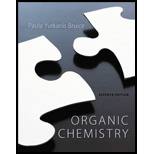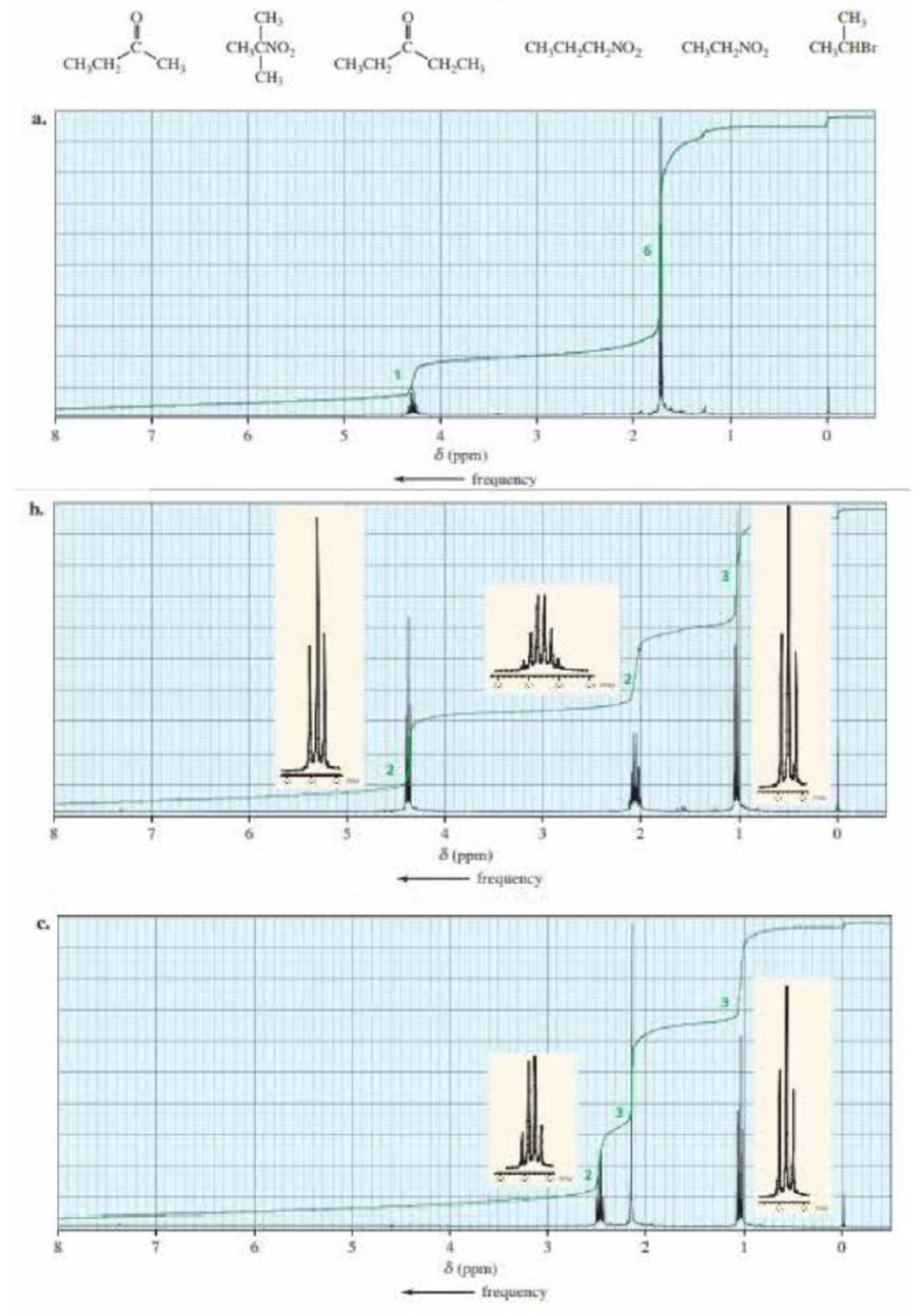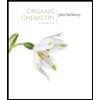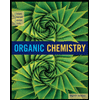
Organic Chemistry; Modified MasteringChemistry with Pearson eText -- ValuePack Access Card; Study Guide and Student Solutions Manual for Organic Chemistry, Books a la Carte Edition (7th Edition)
7th Edition
ISBN: 9780134240152
Author: Paula Yurkanis Bruice
Publisher: PEARSON
expand_more
expand_more
format_list_bulleted
Concept explainers
Textbook Question
Chapter 15, Problem 49P
Match each of the 1H NMR spectra with one of the following compounds:

Expert Solution & Answer
Want to see the full answer?
Check out a sample textbook solution
Students have asked these similar questions
A chemical engineer is studying the two reactions shown in the table below.
In each case, she fills a reaction vessel with some mixture of the reactants and products at a constant temperature of 70.0 °C and constant total pressure.
Then, she measures the reaction enthalpy AH and reaction entropy AS of the first reaction, and the reaction enthalpy AH and reaction free energy AG of the
second reaction. The results of her measurements are shown in the table.
Complete the table. That is, calculate AG for the first reaction and AS for the second. (Round your answer to zero decimal places.) Then, decide whether, under
the conditions the engineer has set up, the reaction is spontaneous, the reverse reaction is spontaneous, or neither forward nor reverse reaction is spontaneous
because the system is at equilibrium.
-
P₁ (s) + 20HF (g). 4PF, (g) + 10H2(g)
AH-1005. kJ
J
AS 2929.
K
AG =
0 kJ
Which is spontaneous?
this reaction
the reverse reaction
neither
AH = 12. kJ
+0=
AS =
SnO2 (s) + 2CO(g) →…
A chemist fills a reaction vessel with 0.281 g silver chromate (Ag₂CrO4) solid, 0.710 M silver (Ag*) aqueous solution, and 0.985 M chromate (CrO2-)
aqueous solution at a temperature of 25.0°C.
Under these conditions, calculate the reaction free energy AG for the following chemical reaction:
Ag2CrO4(s) 2Ag(aq) + CrO4(aq)
Use the thermodynamic information in the ALEKS Data tab. Round your answer to the nearest kilojoule.
4
☐ kJ
x
Draw the structure corresponding to each IUPAC name.
Part 1 of 2
A skeletal structure corresponding to the IUPAC name 3-ethylhexane.
Click and drag to start drawing a
structure.
Chapter 15 Solutions
Organic Chemistry; Modified MasteringChemistry with Pearson eText -- ValuePack Access Card; Study Guide and Student Solutions Manual for Organic Chemistry, Books a la Carte Edition (7th Edition)
Ch. 15.1 - Prob. 1PCh. 15.1 - Prob. 2PCh. 15.4 - How many signals would you expect to see in the 1H...Ch. 15.4 - Prob. 4PCh. 15.4 - How could you distinguish the 1H NMR spectra of...Ch. 15.4 - Draw an isomer of dichlorocyclopropane that gives...Ch. 15.5 - Prob. 7PCh. 15.5 - Prob. 8PCh. 15.5 - Prob. 9PCh. 15.5 - Where would you expect to find the 1H NMR signal...
Ch. 15.6 - Prob. 11PCh. 15.7 - Prob. 12PCh. 15.7 - Prob. 13PCh. 15.7 - Without referring to Table 14.1, label the proton...Ch. 15.8 - [18]-Annulene shows two signals in its 1H NMR...Ch. 15.9 - How would integration distinguish the 1H NMR...Ch. 15.9 - Which of the following compounds is responsible...Ch. 15.10 - Prob. 19PCh. 15.10 - Explain how the following compounds, each with the...Ch. 15.10 - The 1H NMR spectra of two carboxylic acids with...Ch. 15.11 - Draw a diagram like the one shown in Figure 14.12...Ch. 15.12 - Indicate the number of signals and the...Ch. 15.12 - How can their 1H NMR spectra distinguish the...Ch. 15.12 - Identify each compound from its molecular formula...Ch. 15.12 - Prob. 27PCh. 15.12 - Propose structures that are consistent with the...Ch. 15.12 - Describe the 1H NMR spectrum you would expect for...Ch. 15.13 - Prob. 30PCh. 15.13 - Identify the compound with molecular formula...Ch. 15.14 - Prob. 32PCh. 15.15 - a. For the following compounds, which pairs of...Ch. 15.17 - Explain why the chemical shift of the OH proton of...Ch. 15.17 - Prob. 37PCh. 15.17 - Prob. 38PCh. 15.17 - Prob. 39PCh. 15.20 - Answer the following questions for each compound:...Ch. 15.20 - Prob. 41PCh. 15.20 - How can 1,2-, 1,3-, and 1,4-dinitrobenzene be...Ch. 15.20 - Identify each compound below from its molecular...Ch. 15.22 - Prob. 44PCh. 15.22 - What does cross peak X in Figure 14.34 tell you?Ch. 15 - Prob. 46PCh. 15 - Draw a spitting diagram for the Hb proton and give...Ch. 15 - Label each set of chemically equivalent protons,...Ch. 15 - Match each of the 1H NMR spectra with one of the...Ch. 15 - Determine the ratios of the chemically...Ch. 15 - How can 1H NMR distinguish between the compounds...Ch. 15 - Prob. 52PCh. 15 - The 1H NMR spectra of three isomers with molecular...Ch. 15 - Prob. 54PCh. 15 - Prob. 55PCh. 15 - Prob. 56PCh. 15 - Compound A, with molecular formula C4H9Cl, shows...Ch. 15 - The 1H NMR spectra of three isomers with molecular...Ch. 15 - Would it be better to use 1H NMR or 13C NMR...Ch. 15 - There are four esters with molecular formula...Ch. 15 - An alkyl halide reacts with an alkoxide ion to...Ch. 15 - Identity each of the following compounds from its...Ch. 15 - Identity each of the following compounds from its...Ch. 15 - Prob. 64PCh. 15 - How can the signals in the 6.5 to 8.1 ppm region...Ch. 15 - The 1H NMR spectra of two compounds, each with...Ch. 15 - Draw a splitting diagram for the Hb proton if Jbc...Ch. 15 - Sketch the following spectra that would be...Ch. 15 - How can 1H NMR be used to prove that the addition...Ch. 15 - Identity each of the following compounds from its...Ch. 15 - Dr. N. M. Arr was called in to help analyze the 1H...Ch. 15 - Calculate the amount of energy (in calories)...Ch. 15 - The following 1H NMR spectra are four compounds,...Ch. 15 - When compound A (C5H12O) is treated with HBr, it...Ch. 15 - Identity each of the following compounds from its...Ch. 15 - Identify each of the following compounds from its...Ch. 15 - Identity the compound with molecular formula...Ch. 15 - Identify the compound with molecular formula C6H14...
Knowledge Booster
Learn more about
Need a deep-dive on the concept behind this application? Look no further. Learn more about this topic, chemistry and related others by exploring similar questions and additional content below.Similar questions
- Using any data you can find in the ALEKS Data resource, calculate the equilibrium constant K at 25.0 °C for the following reaction. TiC₁₁(g) + 2H₂O(g) → TiO2 (s) + 4HCl (g) 4 Round your answer to 2 significant digits. K = ☐ x10 D Хarrow_forward: ☐ Х Draw an α amino acid with a hydroxyethyl (-CH2-CH2- OH) side chain. Draw the molecule as it would appear at physiological pH. Click and drag to start drawing a structure. 5 Parrow_forwardDraw the product of the reaction shown below. Ignore inorganic byproducts. cat. H2SO4 HNO3 (1 equiv) Drawing Qarrow_forward
- Provide the correct systematic name for the compound shown here.arrow_forwardUsing the appropriate bond energies, calculate the heat of reaction AH for the following reaction: H-H + CI-CI 2 H-CI You can find a table of bond energies by using the Data button on the ALEKS toolbar. Round your answer to the nearest kJ/mol. Note: For clarity, all lone pairs have been omitted from the molecular structures. ☐ kJ mol ค 000 Ar Barrow_forwardPredict the hydrocarbon, of formula C6H10, needed to prepare the following geminal dibromide upon treatment with excess hydrobromic acid. Note: The shown product is the only regioisomer formed in this reaction. HBr H₂C. CH3arrow_forward
- A mixture of CaCO3 and MgC2O4 of unknown mass was heated in a 0.5 L closed rigid vessel to 900 degrees C.at 400C the following reaction occurs:MgC2O4 -> MgO (s) + CO (g) + CO2 (g)At 700C a second reaction occurs: CaCO3 -> CaO (s) + CO2 (g)The solid mass in the vessel was measured to be 3.06 g at 400C and 2.03g at 900CQuestion: What is the partial pressure of CO in both temperatures? (400 and 900C), provide detailed explanation.arrow_forwardFor the following alkyne, complete the reaction sequentially (that is draw the intermediate that we can’t stop at) and then name (complete name) all 3 molecules.arrow_forwardGiven the reaction sequence below, answer the following. A. Provide the structure for A. B. Provide the structure for B (pay attention to stereochemistry). C. Provide the structure for C. D. What are the stereochemical designations for I and II (R/S)?arrow_forward
arrow_back_ios
SEE MORE QUESTIONS
arrow_forward_ios
Recommended textbooks for you

 Organic ChemistryChemistryISBN:9781305580350Author:William H. Brown, Brent L. Iverson, Eric Anslyn, Christopher S. FootePublisher:Cengage Learning
Organic ChemistryChemistryISBN:9781305580350Author:William H. Brown, Brent L. Iverson, Eric Anslyn, Christopher S. FootePublisher:Cengage Learning


Organic Chemistry
Chemistry
ISBN:9781305580350
Author:William H. Brown, Brent L. Iverson, Eric Anslyn, Christopher S. Foote
Publisher:Cengage Learning
NMR Spectroscopy; Author: Professor Dave Explains;https://www.youtube.com/watch?v=SBir5wUS3Bo;License: Standard YouTube License, CC-BY